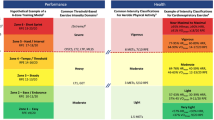Abstract
The maximal aerobic power of six highly trained young cyclist, mean age 16.3 years and mean\(\dot V_{O_2 \max } \) 4.9 l/min, was directly measured at intervals of 4 hrs. A Latin square design was used for the test order.
At submaximal work of O2-consumption 2.4 to 4.4 l/min no circadian variation of any single function was found. However, at maximal work load the differences between the maxima and minima values were 12.4% for maximal work output (\(\dot W_{\max } \)), 7.8% for expiratory minute volume (\(\dot V_{E\max } \)), 5.7% for maximal aerobic power (\(\dot V_{O_2 \max } \)) and 3.4% for maximal heart rate (HR max). All the functions—with the exception of\(\dot V_{O_2 \max } \)—had their minima at 0300 hrs; the minima of\(\dot V_{O_2 \max } \) was reached already at 2300 hours. The maxima-values of\(\dot V_{E\max } \) and\(\dot V_{O_2 \max } \) were measured at 1500 hrs, of\(\dot W_{\max } \) andHR max at 0700 and ofHR rest at 1900 hrs correspondingly. A one-tailed test showed significant differences between the maxima and minima values of all variables (P<0.05).
The results suggest a decreased cardiopulmonary working capacity at night. However, this impairment is only of practical importance if the work will be done near the limit of endurance capacity. Besides it will suggest, that the indirect methods for assessing the cardiopulmonary capacity based on\(\dot V_{O_2 \max } \) and\(\dot W_{170} \) are not useful at nighttime, because the presuppositions for these methods are limited of the time of day.
Zusammenfassung
Bei sechs hochgeübten jugendlichen Radrennfahrern mit einem Durchschnittsalter von 16,3 Jahren und einer durchschnittlichen maximalen O2-Aufnahme von 4,9 l/min wurde die maximale O2-Aufnahme in Abständen von 4 Std direkt bestimmt. Die Versuchsfolge wurde nach dem Lateinischen Quadrat festgelegt.
Im submaximalen Bereich der O2-Aufnahme von 2,4 bis 4,4 l/min waren keine Unterschiede der Einzelfunktionen in Abhängigkeit von der Tageszeit zu finden. Dagegen wurden die folgenden Unterschiede zwischen den Maximal- und Minimalwerten gefunden: für die maximale Leistung\(\dot W_{\max } \) 12,4%, für das maximale Atemzeitvolumen (\(\dot V_{E\max } \)) 7,8%, für die maximale O2-Aufnahme (\(\dot V_{O_2 \max } \)) 5,7% und für die maximale Herzfrequenz (H F max) 3,4%. Alle Funktionen hatten — mit Ausnahme der\(\dot V_{E\max } \) — ihr Minimum um 3.00 Uhr; das Minimum der\(\dot V_{O_2 \max } \) wurde dagegen bereits um 23.00 Uhr erreicht. Die Maxima der\(\dot V_{E\max } \) und\(\dot V_{O_2 \max } \) wurden um 15.00 Uhr, der\(\dot W_{\max } \) undH F max um 7.00 Uhr und derH F Ruhe um 19.00 Uhr gemessen. Die Unterschiede zwischen den Maxima- und Minimawerten nach einseitiger Prüfung waren in allen Einzelfunktionen signifikant (P<0,05).
Die Ergebnisse sprechen für eine geringere kardiopulmonale Leistungsfähigkeit in der Nacht. Diese Verminderung wird aber erst bedeutsam, wenn die Arbeit direkt an der Dauerleistungsgrenze geleistet werden müßte. Außerdem ist daraus zu folgern, daß indirekte Methoden zur Bestimmung der\(\dot V_{O_2 \max } \) sowie die\(\dot W_{170} \) in der Nachtzeit nicht sinnvoll zur Bestimmung der kardiopulmonalen Leistungsfähigkeit eingesetzt werden können, da die Voraussetzungen dieser Methoden auf die Tageszeit eingeschränkt sind.
Similar content being viewed by others
Literatur
Davies, C. T. M., Sargeant, A. J.: Circadian variation in physiological responses to exercise on a stationary bicycle ergometer. Brit. J. Industr. Med.32, 110–114 (1975)
Hildebrandt, G., Engel, P.: The relation between diurnal variations in psychic and physical performance. In: Aspects of human efficiency, W. P. Colquhoun, ed., pp. 231–240. London: The English University Press 1972
Kaneko, M., Zechman, F. W., Smith, R. E.: Circadian variation in human peripheral blood flow levels and exercise responses. J. appl. Physiol.25, 109–114 (1968)
Klein, K. E., Wegmann, H. M., Brüner, H.: Circadian rhythm in indices of human performance, physical fitness and stress resistance. Aerospace Med.39, 512–518 (1968)
Lange Andersen, K., Shephard, R. J., Denolin, H., Varnauskas, E., Masironi, R.: Fundamentals of exercise testing. Geneva: WHO 1971
Tsaneva, N., Dincheva, E., Stojanova, N.: Changes in working capacity at night. Estimation of the maximum working capacity. Proceedings of the Second International Symposium on Night- and Shift-Work, Slanchev Bryag 1971. Studia laboris et salutis report nr. 11, pp. 79–86. Stockholm: Nat. Inst. Occup. Hlth 1972
Voigt, E.-D., Engel, P., Klein, H.: Über den Tagesgang der körperlichen Leistungsfähigkeit. Int. Z. angew. Physiol.25, 1–12 (1968)
Wahlberg, I., Åstrand, I.: Physical working capacity during the day and at night. Wk-Environ.-Hlth10, 65–68 (1973)
Wojtzak-Jaroszowa, J., Banaszkiewicz, A.: Physical working capacity during the day and night. Ergonomics17, 193–198 (1974)
Author information
Authors and Affiliations
Rights and permissions
About this article
Cite this article
Ilmarinen, J., Rutenfranz, J., Kylian, H. et al. Untersuchung zur Tagesperiodik verschiedener Kreislauf-und Atemgrößen bei submaximalen und maximalen Leistungen am Fahrradergometer. Europ. J. Appl. Physiol. 34, 255–267 (1975). https://doi.org/10.1007/BF00999939
Received:
Issue Date:
DOI: https://doi.org/10.1007/BF00999939




